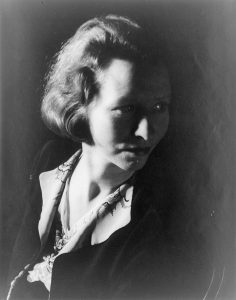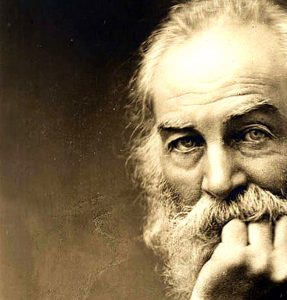Be to her, Persephone,
All the things I might not be;
Take her head upon your knee.
She that was so proud and wild,
Flippant, arrogant and free,
She that had no need of me,
Is a little lonely child
Lost in Hell,—Persephone,
Take her head upon your knee;
Say to her, “My dear, my dear,
It is not so dreadful here.”
From the collection, Second April, published 1921.
Thomas Hardy once said, “America had two great attractions: the skyscraper and the poetry of Edna St. Vincent Millay” and her career certainly reflects such a sentiment. In 1923, Millay (1892-1950) became the third woman to win the Pulitzer Prize for poetry. She grew up with a mother who nurtured her ambition and often read to her works by Shakespeare and Milton. At her mother’s encouragement, Millay entered her poem “Renascence” a contest and placed fourth. Upon the poem’s publication, she earned a scholarship to Vassar College, which she began attending at the age of 21. Millay went on to published 17 books of poetry—the first in 1917 and the most noteworthy in 1920, A Few Figs From Thistles: Poems and Four Sonnets. Figs from Thistles put a spotlight on her in a rather peculiar way. In the collection, she expressed the view that women had every right to sexual pleasure and no obligation to fidelity, a view that reflected her relationship with her husband, Eugen Boissevain, a self-proclaimed feminist. Boissevain and Millay had an open relationship and Millay lived openly as a bisexual woman.
“Prayer to Persephone” is one in a series of poems entitled In Memorial to D.C. and written for a friend who had recently passed away. The poem alludes to Persephone’s abduction, a myth often referred to as “The Rape of Persephone.” Persephone was the daughter of Demeter, Greek Goddess of the harvest. Hades, God of the underworld, fell in love with the beautiful Persephone and carried her away, believing that Demeter would not permit her daughter to go willingly. Waiting for Hades to return Persephone, Demeter is thrust into a misery so great that she neglects her obligations to the earth and crops begin to fail. The cries of hungry people urge Zeus to demand that Hades release Persephone. Yet, before complying, Hades tricks Persephone into eating pomegranate seeds and because she has consumed the fruit of underworld, she is obliged to spend a third of the year in Hades, time which often coincides with the colder months of the year.
Despite the allusion to Persephone, the speaker of this poem is not necessarily Demeter. Rather, it is an individual, perhaps a parent who has lost a child. Millay’s poem is enriched by imagery and language that captures the grief of loss. She juxtaposes the image of a young girl “so proud and wild, / Flippant, arrogant and free” against that of a “little lonely child / Lost in Hell.” Not only do we see the loss of Persephone’s vigor, but also see the way in which she has been isolated. The speaker calls to Hades, asking him to comfort the girl with rhyming lines that seem to sing to the reader, “‘My dear, my dear, / It is not so dreadful here,’” an effect quite fitting for one of the Jazz Age’s most famous poets. The poem’s rhyme scheme reflects the idea of transition (AAABAABAACC), the idea that people exist in a continuous state of alternation that inevitably ends on a different plane (i.e. Hades). The repetition of words ending with “e” sounds adds a youthful element to the poem, evoking memories of childhood rhymes. The innocence of this evocation contrasts with the somber subject of the poem, reminding us that life is not only full of contradictions, but it is also defined by the constant process of loss—loss of innocence, love, and eventually ourselves. Though the poem is certainly mournful, there is still a blossoming of hope at the end. The speaker does not imagine her Persephone trapped and isolated, but rather she is in the company of another, being comforted. Millay invites us to view death with less fear.
–Arlette Hernandez



 imagery, Driskell creates a sense of mystery that is dominant throughout “What the Girl Wore” until the final line of the poem, when it is finally revealed that the blue dress with a bodice “as smocked/as a christening gown” is to be worn by the recently deceased Lisa. In an effort to mislead the reader, Driskell maintains an unusually apathetic tone, however, some of her double entendres suggest a more complex reason for the poem’s lack of emotion: perhaps Driskell is mirroring our tendency to suppress emotions in the face of great tragedy and sadness. Furthermore, the speaker’s impassivity could carry implications of Lisa’s own alienation from those around her prior to her death—while the speaker is familiar enough with Lisa to understand her fashion preferences, she refers to herself merely as one of Lisa’s classmates as she “file[s] past the white coffin.”
imagery, Driskell creates a sense of mystery that is dominant throughout “What the Girl Wore” until the final line of the poem, when it is finally revealed that the blue dress with a bodice “as smocked/as a christening gown” is to be worn by the recently deceased Lisa. In an effort to mislead the reader, Driskell maintains an unusually apathetic tone, however, some of her double entendres suggest a more complex reason for the poem’s lack of emotion: perhaps Driskell is mirroring our tendency to suppress emotions in the face of great tragedy and sadness. Furthermore, the speaker’s impassivity could carry implications of Lisa’s own alienation from those around her prior to her death—while the speaker is familiar enough with Lisa to understand her fashion preferences, she refers to herself merely as one of Lisa’s classmates as she “file[s] past the white coffin.”


